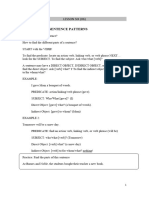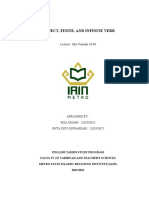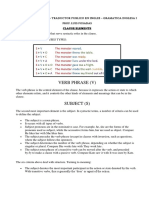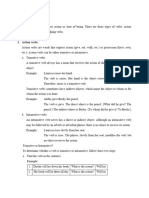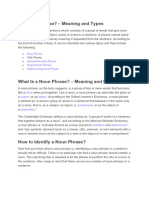100%(1)100% found this document useful (1 vote)
134 viewsSentence Pattern Project: Terms Example Illustration
The document defines different sentence patterns in English grammar:
1. SV (Subject-Verb) refers to basic subject-verb agreement and includes examples like "The dog chases the cat."
2. SVO (Subject-Verb-Object) is the basic sentence structure including subject, verb, and object, with examples like "She drinks coffee."
3. SVC (Subject-Verb-Complement) includes a complement that follows a linking verb and describes the subject, with examples like "The box is big."
Uploaded by
Logkeetha SarckunadasanCopyright
© © All Rights Reserved
Available Formats
Download as DOCX, PDF, TXT or read online on Scribd
100%(1)100% found this document useful (1 vote)
134 viewsSentence Pattern Project: Terms Example Illustration
The document defines different sentence patterns in English grammar:
1. SV (Subject-Verb) refers to basic subject-verb agreement and includes examples like "The dog chases the cat."
2. SVO (Subject-Verb-Object) is the basic sentence structure including subject, verb, and object, with examples like "She drinks coffee."
3. SVC (Subject-Verb-Complement) includes a complement that follows a linking verb and describes the subject, with examples like "The box is big."
Uploaded by
Logkeetha SarckunadasanCopyright
© © All Rights Reserved
Available Formats
Download as DOCX, PDF, TXT or read online on Scribd
You are on page 1/ 2
Sentence Pattern Project
Terms Definition Example Illustration
SV (Subject -Verb) e.g. Subject verb agreement means 1. The dog chases the cat. singular no ‘s’ singular ‘s’
that the subject and the verb must (singular form)
agree in case and in number 2. The dogs chase the cat. (plural The dog chases the cat.
form)
noun subject verb
SVO (Subject-Verb-Object) Subject + Verb + Object combine to 1. She drinks coffee.
make basic English sentences. (singular form)
Subject : who/what the sentence is 2. Those boys are my brothers.
about. (plural form)
Verb : what the subject does/is.
Object : a person or thing that is
affected by the action of a verb.
SVC (Subject-Verb-Compliment) A subject verb compliment is a word 1. The box is big.
or phrase that follows a linking verb (singular form)
and describes the subject. A linking 2. Those students dance
verb is a verb used to link a subject to gracefully.
a description. A subject compliment (plural form)
can be either an adjective, a noun or
a pronoun.
SVOO (Subject-Verb-Indirect Object- An indirect object is a prepositional 1. The teacher teaches us
Direct Object) phrase in which the preposition to or English.
for is not stated but understood. It (singular form)
tells to whom or for whom something 2. My students presented me
is done. The indirect object always gifts on Teacher’s Day.
comes between the verb and the (plural form)
direct object.
SVOA (Subject-Verb-Object- Basically, an adverbial can be a 1. He wrote a letter from Paris.
Adverbial) prepositional phrase (Example : from (singular form)
Paris) 2. They need money
Or an adverb (Example : immediately.
immediately). A group of two or more (plural form)
words that function as an adverb in a
sentence is known as adverb phrase.
An adverb phrase normally further
describes a verb, adverb or adjective.
SVOC (Subject-Verb-Object- After some verbs, an object alone 1. He made his son a doctor.
Complement) does not make complete sense. In (singular form)
order to complete the meaning of the 2. They painted the wall white.
object, complement will be used. (plural form)
Which means the direct object is
followed by a group of words that
completes the object’s meaning by
renaming or describing it.
You might also like
- Parallel Concurrent Processing Failover and Load Balancing of E-Business Suite Release 11i and Release 12 Mike Swing, TruTek PDF100% (1)Parallel Concurrent Processing Failover and Load Balancing of E-Business Suite Release 11i and Release 12 Mike Swing, TruTek PDF52 pages
- Sentence Pattern Project: Terms Example Illustration100% (1)Sentence Pattern Project: Terms Example Illustration2 pages
- Subject, Finite and Infinite Verb. Advance Grammar and StructureNo ratings yetSubject, Finite and Infinite Verb. Advance Grammar and Structure14 pages
- 2 The Main and Secondary Parts of A SentenceNo ratings yet2 The Main and Secondary Parts of A Sentence26 pages
- English 10 Elements of Creative NonfictionNo ratings yetEnglish 10 Elements of Creative Nonfiction24 pages
- Powerpoint Presentation By: Eisha Sabila Dieni Hanifa (2001709/1B2) 20200% (1)Powerpoint Presentation By: Eisha Sabila Dieni Hanifa (2001709/1B2) 202020 pages
- English Grammar I Dept. of English Letters Faculty of Letters Universitas Sanata DharmaNo ratings yetEnglish Grammar I Dept. of English Letters Faculty of Letters Universitas Sanata Dharma25 pages
- Greetings Prayer Rules Attendance: HI Everyone!!No ratings yetGreetings Prayer Rules Attendance: HI Everyone!!30 pages
- Subject:: Simple Subject and Simple PredicateNo ratings yetSubject:: Simple Subject and Simple Predicate5 pages
- Nouns: Noun: Definition, Rules, Examples and List of Nouns in English GrammarNo ratings yetNouns: Noun: Definition, Rules, Examples and List of Nouns in English Grammar39 pages
- Phrases - and - Clauses - Exercise - 1 LOGKEETHATHAEVYNo ratings yetPhrases - and - Clauses - Exercise - 1 LOGKEETHATHAEVY2 pages
- List The FOUR Types of Sentences in English.: Syntax: Language and StructureNo ratings yetList The FOUR Types of Sentences in English.: Syntax: Language and Structure1 page
- Curriculum Induction Training 2020 END OF COURSENo ratings yetCurriculum Induction Training 2020 END OF COURSE1 page
- Word - Formation - Exercise - 1 LOGKEETHATHAEVYNo ratings yetWord - Formation - Exercise - 1 LOGKEETHATHAEVY1 page
- The Curriculum Documents: An Introductory Part WhichNo ratings yetThe Curriculum Documents: An Introductory Part Which2 pages
- MPU 3273/ LANG 2128/ BLC 221: Professional CommunicationNo ratings yetMPU 3273/ LANG 2128/ BLC 221: Professional Communication17 pages
- Kpop Dance Competition Smartfren ProposalNo ratings yetKpop Dance Competition Smartfren Proposal6 pages
- Cambridge English: Key: 145 Reading and WritingNo ratings yetCambridge English: Key: 145 Reading and Writing6 pages
- Anchoring Script For The Event of 25TH January100% (1)Anchoring Script For The Event of 25TH January3 pages
- Glossary of GurSikh - 11th Vaar of Bhai Gurdaas-1 PDF100% (1)Glossary of GurSikh - 11th Vaar of Bhai Gurdaas-1 PDF45 pages
- 75 Days Study Plan SSC CGL 1537957545 14No ratings yet75 Days Study Plan SSC CGL 1537957545 1411 pages
- PDF Levi Strauss Anthropology and Aesthetics 1st Edition Boris Wiseman download100% (10)PDF Levi Strauss Anthropology and Aesthetics 1st Edition Boris Wiseman download71 pages
- zCEE Customization Security and CICS PDFNo ratings yetzCEE Customization Security and CICS PDF26 pages
- 11 Ghost in The Air (Traffic) On Insecurity of ADS-B Protocol and Practical Attacks On ADS-B DevicesNo ratings yet11 Ghost in The Air (Traffic) On Insecurity of ADS-B Protocol and Practical Attacks On ADS-B Devices10 pages
- Organizational Behavior: Chapter No 11 CommunicationNo ratings yetOrganizational Behavior: Chapter No 11 Communication27 pages
- Collecting From The Margins Material Culture in A Latin American Context (María Mercedes Andrade)No ratings yetCollecting From The Margins Material Culture in A Latin American Context (María Mercedes Andrade)242 pages





